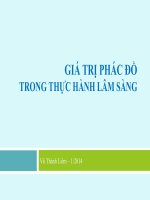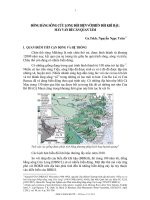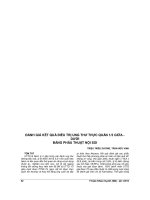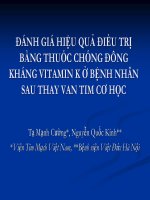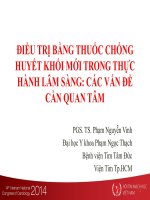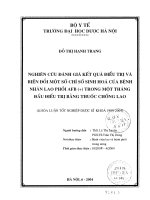ĐIỀU TRỊ BẰNG THUỐC CHỐNG HUYẾT KHỐI mới TRONG THỰC HÀNH lâm SÀNG các vấn đề cần QUAN tâm
Bạn đang xem bản rút gọn của tài liệu. Xem và tải ngay bản đầy đủ của tài liệu tại đây (1.28 MB, 35 trang )
ĐIỀU TRỊ BẰNG THUỐC CHỐNG
HUYẾT KHỐI MỚI TRONG THỰC
HÀNH LÂM SÀNG: CÁC VẤN ĐỀ
CẦN QUAN TÂM
PGS. TS. Phạm Nguyễn Vinh
Đại học Y khoa Phạm Ngọc Thạch
Bệnh viện Tim Tâm Đức
Viện Tim Tp.HCM
1
Đt bằng thuốc chống huyết khối mới trong thực hành lâm sàng: các vấn đề cần quan tâm
Một vài định nghĩa
• Thuốc chống huyết khối (antithrombotics): ngăn ngừa và điều
trị huyết khối; bao gồm: thuốc kháng đông (anti coagulants),
thuốc chống kết tập tiểu cầu (anti platelets) và thuốc tiêu sợi
huyết (fibrinolytics)
• Thuốc kháng đông: tác động lên thrombin hoặc yếu tố Xa hoặc
nhiều yếu tố (TD: warfarin)
• Thuốc chống kết tập tiểu cầu: aspirin, clopidogrel, prasugrel,
ticagrelor
• Thuốc tiêu sợi huyết: phân hủy cục máu đông. streptokinase,
urokinase, r-tPA, tenecteplase
Đt bằng thuốc chống huyết khối mới trong thực hành lâm sàng: các vấn đề cần quan tâm
Chỉ định của thuốc kháng đông
• Phòng ngừa và điều trị huyết khối trên bệnh
nhân rung nhĩ
• Phòng ngừa và điều trị huyết khối tĩnh mạch
sâu
• Phòng ngừa và điều trị thuyên tắc phổi
• Đột quỵ: phòng ngừa và điều trị
• Van cơ học: chỉ dùng thuốc kháng vitamin K
và heparin
3
Đt bằng thuốc chống huyết khối mới trong thực hành lâm sàng: các vấn đề cần quan tâm
Các thuốc kháng đông mới đã được
chấp nhận (FDA, EU)
• Dabigatran (N/c RELY)*
• Apixaban (N/c ARISTOTLE)**
• Rivaroxaban (N/c ROCKET AF)***
*Connolly S et al. NEJM 2009; 361: 1139-1151
** Fox et al. Eur Heart J 2001; 32: 2387-2394
*** Hohnloser S et al. Eur Heart J 2012; 33: 2821-2831
4
Đt bằng thuốc chống huyết khối mới trong thực hành lâm sàng: các vấn đề cần quan tâm
*Theoretical rates without therapy corrected for the percentage of
patients receiving Aspirin within each group,
assuming 22% reduction in risk with Aspirin
Adapted from Lip G et al. Chest 2010;137:263–72
CHA
2
DS
2-
VASc
criteria
Score
Congestive heart failure/
left ventricular dysfunction
1
Hypertension 1
Age 75 yrs
2
Diabetes mellitus 1
Stroke/transient ischaemic attack/TE 2
Vascular disease
(prior myocardial infarction, peripheral
artery disease or aortic plaque)
1
Age 65–74 yrs 1
Sex category (i.e. female gender) 1
CHA
2
DS
2
-VASc
total score
Rate of stroke/other TE
(%/yr) (95% CI)*
0 0 (0–0)
1 0.6 (0.0–3.4)
2 1.6 (0.3–4.7)
3 3.9 (1.7–7.6)
4 1.9 (0.5–4.9)
5 3.2 (0.7–9.0)
6 3.6 (0.4–12.3)
7 8.0 (1.0–26.0)
8 11.1 (0.3–48.3)
9 100 (2.5–100)
5
Nguy cơ đột quỵ/RN dựa theo chỉ số
CHA
2
DS
2
-VASc
Đt bằng thuốc chống huyết khối mới trong thực hành lâm sàng: các vấn đề cần quan tâm
Thang điểm đánh giá nguy cơ chảy máu HAS- BLED
• HAs- BLED ≥ 3: nguy cơ chảy máu cao
• Huyết áp cao: khi huyết áp tâm thu > 160 mmHg
• Bất thường chức năng thận: khi bệnh nhân đang chạy thận nhân tạo định kỳ, ghép thận, hoặc creatinine máu ≥ 200 µmol/L
• Bất thường chức năng gan: khi có bệnh gan mạn (vd: xơ gan), hoặc có bằng chứng sinh hoá của xáo trộn chức năng gan nặng (vd:
bilirubin > 2 lần giới hạn trên bình thường, hoặc AST/ALT/Phosphatase kiềm > 3 lần giới hạn trên bình thường)
• Chảy máu: khi bệnh nhân có tiền sử chảy máu, và/ hoặc có yếu tố thúc đẩy chảy máu (vd: chảy máu nội tạng, thiếu máu…)
• INR dao động: khi INR cao hoặc không ổn định, hoặc thời gian trong khoảng điều trị thấp (TTR, Time in Therapeutic Range, thời gian
INR đạt trong ngưỡng điều trị < 60%)
• Thuốc/Rượu: các thuốc điều trị đi kèm như thuốc chống kết tập tiểu cầu, kháng viêm non-steroides, hoặc nghiện rượu,…
6
Chữ Đặc điểm lâm sàng Điểm số
H
Hypertension
(Huyết áp cao) 1
A
Abnormal
renal and liver function (Bất thường chức năng gan
và thận, mỗi cái 1 điểm)
1 hoặc 2
S
Stroke
(Đột quỵ) 1
B
Bleeding (Chảy
máu) 1
L
Labile INR (Dao động
INR) 1
E
Elderly (Cao tuổi,
tuổi > 65) 1
D
Thuốc/rượu
(Mỗi cái 1 điểm) 1 hoặc 2
Tối đa 9 điểm
Đt bằng thuốc chống huyết khối mới trong thực hành lâm sàng: các vấn đề cần quan tâm
Phòng ngừa và điều trị huyết
khối trên bệnh nhân rung nhĩ
Đt bằng thuốc chống huyết khối mới trong thực hành lâm sàng: các vấn đề cần quan tâm
Điều trị rung nhĩ
• 3 mục tiêu :
• Kiểm soát tần số thất
• Phòng ngừa huyết khối thuyên tắc
• Chuyển nhịp và duy trì
8
TL : Circulation 2006 : 114 ; e 257 – e 354
Đt bằng thuốc chống huyết khối mới trong thực hành lâm sàng: các vấn đề cần quan tâm
9
Recommendation Class Level
When adjusted-dose VKA (INR 2–3) cannot be used in a patient with
AF where an OAC is recommended, due to difficulties in keeping within
therapeutic anticoagulation, experiencing side effects of VKAs, or
inability to attend/undertake INR monitoring, one of the NOACs, either:
a direct thrombin inhibitor (dabigatran); or
an oral Factor Xa inhibitor (e.g. rivaroxaban, apixaban*)
… is recommended
I B
When an OAC is recommended, one of the NOACs, either:
a direct thrombin inhibitor (dabigatran); or
an oral Factor Xa inhibitor (e.g. rivaroxaban, apixaban*)
… should be considered rather than adjusted-dose VKA
(INR 2–3) for most patients with nonvalvular AF, based on their
net clinical benefit
IIa A
*Pending approval; BID = twice daily; INR = international normalized ratio; NOAC = novel oral anticoagulant;
VKA = vitamin K antagonist
Khuyến cáo về sử dụng kháng đông mới (1)
Đt bằng thuốc chống huyết khối mới trong thực hành lâm sàng: các vấn đề cần quan tâm
10
Recommendation Class Level
When dabigatran is prescribed, a dose of 150 mg BID should be
considered for most patients in preference to 110 mg BID, with the
latter dose recommended in:
elderly patients, age ≥80 years
concomitant use of interacting drugs (e.g. verapamil)
high bleeding risk (HAS-BLED score ≥3)
moderate renal impairment (CrCl 30–49 mL/min)
IIa B
Where rivaroxaban is being considered, a dose of 20 mg OD should be
considered for most patients in preference to 15 mg OD, with the latter
dose recommended in:
•high bleeding risk (HAS-BLED ≥3)
•moderate renal impairment (CrCl 30–49 mL/min)
IIa C
European Heart Journal 2012;33:2719-2747
BID = twice daily; CrCl = creatinine clearance; OD = once daily
AS-bi10-1112
Khuyến cáo về sử dụng kháng đông mới (2)
Đt bằng thuốc chống huyết khối mới trong thực hành lâm sàng: các vấn đề cần quan tâm
Sử dụng kháng đông mới/
trường hợp đặc biệt (1)
• Đang sử dụng dabigatran, thử aPTT thấy
dài, không dùng tiêu sợi huyết
• Đột quỵ TMCB khi đang dùng
rivaroxaban hay apixaban, cân nhắc
chuyển qua dabigatran 150 mg x 2/ng
AIS
(Đột quỵ
TMCB)
• Hiện nay chưa có chứng cứ về lợi ích khi cắt
đốt bằng catheter mà không ngưng kháng
đông mới
• Dữ kiện một số cases, ngưng dabigatran khi
cắt đốt sẽ tăng biến cố huyết khối thuyên tắc
Ablation
(Cắt đốt)
AIS = acute ischaemic stroke; aPTT = activated partial thromboplastin time; BID = twice daily;
ESC = European Society of Cardiology; NOAC = novel oral anticoagulant
Camm AJ et al. Eur Heart J 2012;33:2719–47
11
Disclaimer: Dabigatran etexilate, rivaroxaban, and apixaban are approved for
clinical use in stroke prevention in atrial fibrillation in certain countries.
Please check local prescribing information for further details
Đt bằng thuốc chống huyết khối mới trong thực hành lâm sàng: các vấn đề cần quan tâm
Sử dụng kháng đông mới/
trường hợp đặc biệt (2)
• Available data suggest cardioversion can be safely
performed on dabigatran
• OAC should be continued long-term (VKA or
dabigatran)
• No published data for rivaroxaban or apixaban
Cardioversion
(Chuyển
nhịp)
ACS = acute coronary syndrome; BID = twice daily; CV = cardiovascular; ESC = European Society
of Cardiology; NOAC = novel oral anticoagulant; OAC = oral anticoagulation; OD = once daily;
VKA = vitamin K antagonist
Camm AJ et al. Eur Heart J 2012;33:2719–47
12
Disclaimer: Dabigatran etexilate, rivaroxaban, and apixaban are approved for clinical
use in stroke prevention in atrial fibrillation in certain countries.
Please check local prescribing information for further details
Đt bằng thuốc chống huyết khối mới trong thực hành lâm sàng: các vấn đề cần quan tâm
13
Yes
Atrial fibrillation
Valvular AF*
<65 years and lone AF (including females)
Assess risk of stroke
CHA
2
DS
2
-VASc score
Assess bleeding risk
(HAS-BLED score)
Consider patient values and preferences
No antithrombotic
therapy
Oral anticoagulant therapy
NOAC VKA
0
1
No (i.e. nonvalvular)
Yes
No
≥2
European Heart Journal 2012;33:2719-2747
Antiplatelet therapy with ASA plus
clopidogrel or – less effectively – ASA only,
should be considered in patients who
refuse any OAC or cannot tolerate
anticoagulation for reasons unrelated to
bleeding. If there are contraindications to
OAC or antiplatelet therapy, left atrial
appendage occlusion, closure or excision
may be considered
Colour CHA
2
DS
2
-VASc: green = 0, blue = 1,
red ≥2; line: solid = best option; dashed =
alternative option
*Includes rheumatic valvular disease and
prosthetic valves; ASA = acetylsalicylic
acid; NOAC = novel oral anticoagulant;
VKA = vitamin K antagonist
AS-bi17-1112
Lựa chọn kháng đông
Đt bằng thuốc chống huyết khối mới trong thực hành lâm sàng: các vấn đề cần quan tâm
Các hạn chế của kháng vit K so với
dabigatran
TL: Huisman MV et al. Thrombo Haemost
2012; 107: 838-847
14
Đt bằng thuốc chống huyết khối mới trong thực hành lâm sàng: các vấn đề cần quan tâm
Hiệu quả phòng ngừa đột quỵ của NOAC
so với Warfarin
Not head-to-head comparison – for illustrative purposes only – adapted from references 1–4
AT = as treated; Dabi 110/150 = dabigatran 110 mg/150 mg twice daily; HR = hazard ratio;
ITT = intention-to-treat; NOAC = new oral anticoagulant; riva = rivaroxaban
1. Connolly SJ et al. N Engl J Med 2009;361:1139–51; 2. Connolly SJ et al. N Engl J Med
2010;363:1875–6;
3. Patel MR et al. N Engl J Med 2011;365:883–91; 4. Granger C et al. N Engl J Med 2011;365:981–92
15
199 (1.19) 250 (1.51)
184 (1.65) 221 (1.96)
NOAC Warfarin
0.5 1.0
Favours NOAC Favours warfarin
HR 95% CI
0.65–0.95
0.79
0.70–1.03 0.85
171 (1.44) 186 (1.58) Dabi 110
(ITT)
0.74–1.12
0.91
1.5 0.0
Riva
(Safety AT)
Apixaban
(ITT)
122 (1.01) 186 (1.58) Dabi 150
(ITT)
0.51–0.81
0.64
No of events (%/yr)
2.0
NOAC: kháng đông mới
Đt bằng thuốc chống huyết khối mới trong thực hành lâm sàng: các vấn đề cần quan tâm
Bệnh nhân đang sử dụng dabigatran,
cần can thiệp hay phẫu thuật có gia
tăng nguy cơ chảy máu?
16
Đt bằng thuốc chống huyết khối mới trong thực hành lâm sàng: các vấn đề cần quan tâm
• Peri-procedural clinical outcomes
subgroup analysis from the RE-LY trial
17
Disclaimer: Dabigatran etexilate is now approved for clinical use in stroke
prevention in atrial fibrillation in certain countries.
Please check local prescribing information for further details
Đt bằng thuốc chống huyết khối mới trong thực hành lâm sàng: các vấn đề cần quan tâm
Biến cố chảy máu quanh thủ thuật: so sánh nhóm
dabigatran với nhóm warfarin
* Không tăng nguy cơ chảy máu khi so sánh giữa 2 liều dabigatran với warfarin
D110 = dabigatran 110 mg twice daily; D150 = dabigatran 150 mg twice daily;
RBC = red blood cell; RR = relative risk
Healey JS et al. Circulation 2012 doi:10.1161/CIRCULATIONAHA.111.090464
Disclaimer: Dabigatran etexilate is now approved for clinical use in stroke
prevention in atrial fibrillation in certain countries.
Please check local prescribing information for further details
18
% patients D110 vs warfarin D150 vs warfarin
D110
n=1487
D150
n=1546
Warfarin
n=1558
RR
(95% CI)
P
value
RR
(95% CI)
P
value
Major
bleeding
3.8 5.1 4.6 0.83
(0.59–1.17)
0.28 1.09
(0.80–1.49)
0.58
Fatal bleeding 0.2 0.1 0.1 1.57
(0.26–9.39)
0.62 1.01
(0.14–7.15)
0.99
Re-operation 0.6 1.4 1.0 0.59
(0.26–1.33)
0.20 1.39
(0.73–2.63)
0.32
RBC
transfusion
3.3 3.5 4.0 0.81
(0.56–1.18)
0.27 0.86
(0.60–1.23)
0.42
Minor
bleeding
8.1 9.0 7.8 1.03
(0.81–1.31)
0.81 1.15
(0.91–1.45)
0.24
Đt bằng thuốc chống huyết khối mới trong thực hành lâm sàng: các vấn đề cần quan tâm
Biến cố huyết khối thuyên tắc quanh thủ thuật: so sánh
nhóm dabigatran với nhóm warfarin
• Tần suất mới mắc thấp ở cả 3 nhóm nghiên cứu
CV cardiovascular; D110 = dabigatran 110 mg twice daily; D150 = dabigatran 150 mg twice daily;
RR = relative risk; SE =systemic embolism
Healey JS et al. Circulation 2012 doi:10.1161/CIRCULATIONAHA.111.090464
Disclaimer: Dabigatran etexilate is now approved for clinical use in
stroke prevention in atrial fibrillation in certain countries.
Please check local prescribing information for further details
19
% patients D110 vs warfarin D150 vs warfarin
D110
n=1487
D150
n=1546
Warfarin
n=1558
RR
(95% CI)
P
value
RR
(95% CI)
P value
Ischaemic
stroke or SE
0.5 0.5 0.5 1.05
(0.55–2.01)
0.89 1.01
(0.35–2.87)
0.99
Stroke
(all cause)
0.5 0.5 0.6 0.73
(0.28–1.92)
0.53 0.71
(0.27–1.85)
0.48
SE 0.1 0.1 0.1 1.05
(0.07–16.7)
0.97 1.01
(0.06–16.1)
1.00
CV death 0.6 0.5 0.5 1.35
(0.50–3.61)
0.55 1.01
(0.35–2.96)
0.99
Đt bằng thuốc chống huyết khối mới trong thực hành lâm sàng: các vấn đề cần quan tâm
The Long Term Multi-Center Extension of
Dabigatran Treatment in Patients with
Atrial Fibrillation (RELY-ABLE) study
• Stuart J. Connolly, Lars Wallentin, Michael Ezekowitz, John
Eikelboom, Jonas Oldgren, Janice Pogue, Paul Reilly, Martina
Brueckmann, Salim Yusuf; on behalf of the RELY-ABLE
Steering Committee and Investigators
20
Đt bằng thuốc chống huyết khối mới trong thực hành lâm sàng: các vấn đề cần quan tâm
Kết luận của RELYABLE
• During 2.3 years of additional treatment after RE-LY (total
mean follow up 4.3 years), rates of stroke and major bleeding
remain low on dabigatran and are consistent with those seen
during RE-LY
• Dabigatran 150 mg BID versus dabigatran 110 mg BID
– Both doses have very low rates of haemorrhagic stroke
during 4+ years
– With dabigatran 150 mg BID, lower rate of ischaemic
stroke, but a higher rate of major bleeding
– Both doses have similar mortality
21
Đt bằng thuốc chống huyết khối mới trong thực hành lâm sàng: các vấn đề cần quan tâm
Xử trí biến cố chảy máu nặng trên
bệnh nhân sử dụng dabigatran
hoặc warfarin
22
Đt bằng thuốc chống huyết khối mới trong thực hành lâm sàng: các vấn đề cần quan tâm
Management and outcomes of major
bleeding on dabigatran or warfarin
Ammar Majeed,
1
Hun-Gyu Hwang,
2
Martina Brueckmann,
3
Stuart Connolly,
4
John Eikelboom,
4
Michael Ezekowitz,
5
Lars Wallentin,
6
Salim Yusuf
4
,
and Sam Schulman
4
Disclaimer: Dabigatran etexilate is now approved for clinical use in stroke prevention in atrial fibrillation in certain countries.
Please check local prescribing information for further details
23
1
Hematology Center, Karolinska University Hospital and Karolinska Institute, Stockholm, Sweden;
2
Soon Chun Hyang University Hospital, Gumi, South Korea;
3
Boehringer Ingelheim Pharma GmbH
& Co. KG, Ingelheim, Germany;
4
Department of Medicine, McMaster University, Hamilton, ON, Canada;
5
Jefferson Medical College, Wynnewood, PA;
6
Uppsala Clinical Research Center, Uppsala, Sweden
Đt bằng thuốc chống huyết khối mới trong thực hành lâm sàng: các vấn đề cần quan tâm
Xử trí chảy máu trên bệnh nhân đang sử dụng
dabigatran:vai trò của yếu tố đông máu đậm đặc (CFCs)
• There is some experimental evidence to support the role of CFCs in
reversing the anticoagulant effect of dabigatran (e.g. in cases of overdose or
major bleeding)*
*Recommendation based only on limited non-clinical data; there is almost no experience in volunteers or patients
CFC = coagulation factor concentrate; PCC = prothrombin complex concentrate; rFVIIa = recombinant activated
Factor VIIa; Eerenberg ES et al. Circulation 2011;124:1573–9; van Ryn J et al. Thromb Haemost 2010;103:1116–27;
PRADAXA emergency guide; available at
documents/emergency-guide-24jan2012-v14.PDF; accessed December 2012
Disclaimer: Dabigatran etexilate is now approved for clinical use in stroke prevention in atrial fibrillation in certain countries.
Please check local prescribing information for further details
24
Patient with bleeding on dabigatran therapy
Mild bleeding
Moderate to severe bleeding
Life-threatening bleeding
Delay next dose or
discontinue treatment as
appropriate
• Symptomatic treatment
• Mechanical compression
• Surgical intervention
• Fluid replacement and hemodynamic support
• Blood product transfusion
• Oral charcoal application*
(if dabigatran ingested <2 hours before)
• Haemodialysis
• Consideration of rFVlla
or PCC*
• Charcoal filtration*
CFCs= coagulation factor concentrates
Đt bằng thuốc chống huyết khối mới trong thực hành lâm sàng: các vấn đề cần quan tâm
Kết luận về xử trí biến cố chảy máu nặng
trên b/n dabigatran hoặc warfarin
• Mặc dù không thuốc đối kháng (antidote), phương
tiện xử trí xuất huyết do dabigatran không nhiều
• Dabigatran an toàn hơn warfarin về b/c xuất huyết
• Đang chờ nghiên cứu về antidote cho dabigatran
Disclaimer: Dabigatran etexilate is now approved for clinical use in stroke prevention in atrial fibrillation in certain countries.
Please check local prescribing information for further details
25
Clinical implications:
Dabigatran’s safety profile is more favourable than that of warfarin, even in the
presence of effective reversal agents for warfarin
The management of severe bleeding on dabigatran can be further improved by
access to a specific antidote, which is in development
